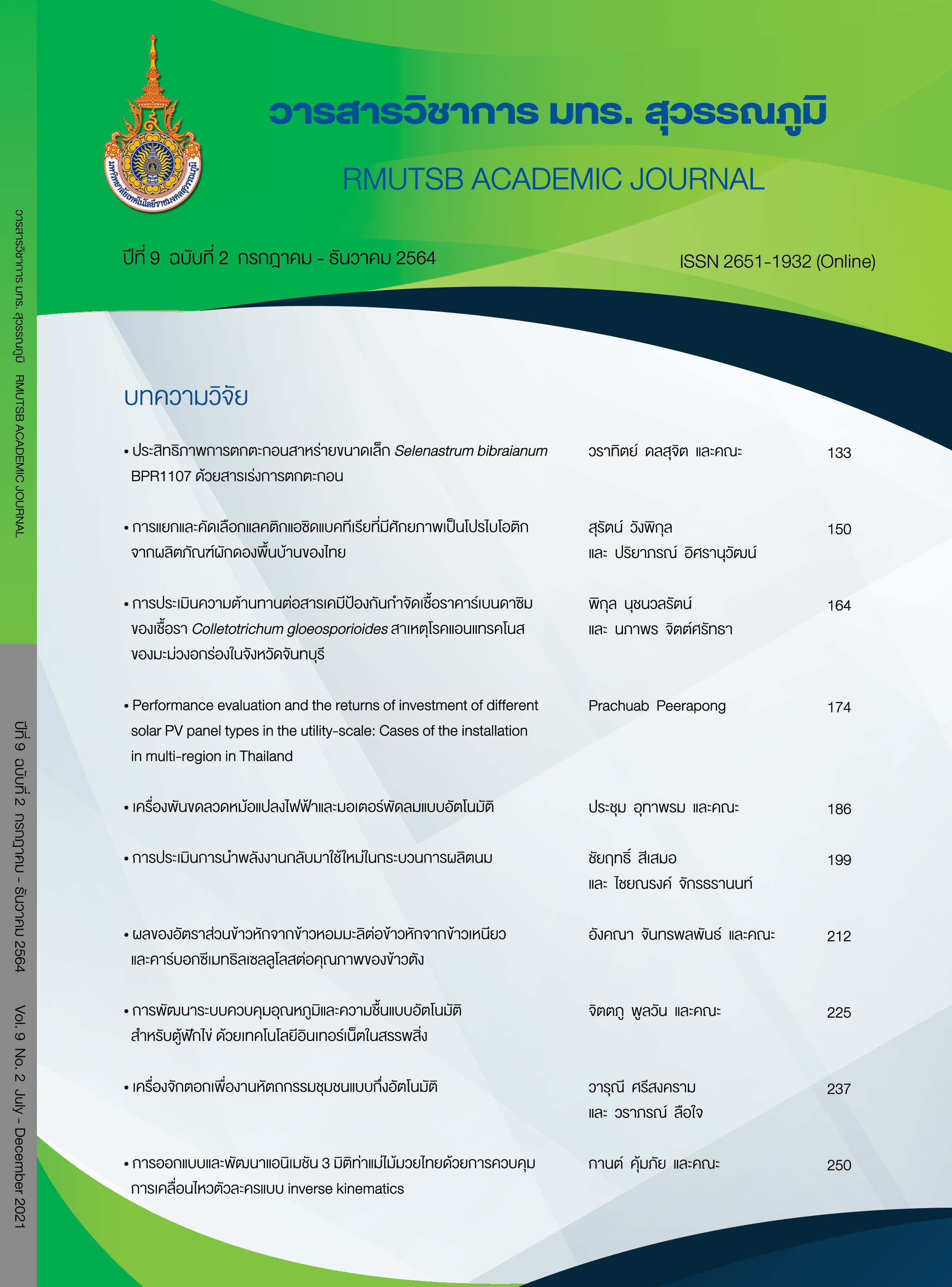Semi-automatic bamboo-stripes machine for community handicraft
Main Article Content
Abstract
This research presents to create a thin bamboo-stripes machine instead of using manual labor for the handicraft. The machine consists of the mechanism for making or shaping bamboo to the desired size by using motor to drive a pulley belt, and an electrical control system for automatic controlling and displaying the consumption of electrical energy during working with a safety protection. The machine is compact and convenient for use in community groups or households. The capability results found that this machine could sharp the bamboo which were strong and had different types of bamboo skin. The machine cut the bamboo-stripes to the minimum thickness of 1 mm. Each 1-time operation could produce the bamboo-stripes into 2 pieces and create at least 200 pieces within 5 minutes. The automatic control could be effectively activated, along with the protected system which showed display the energy value on the panel. An experiment was carried out on 3 types of bamboo-stripes, which were the same length. It was found that the average quantity and quality of bamboo-stripes obtained no different. As the results, the bamboo-stripes shaping with a length of 60 cm and a thickness of 7 mm could produce 117 pieces per minute, and 7,020 per hour. The speed was better than the manual labor by 7 times which, the workers could make 1,003 pieces per hour, showing this machine could reduce labor and working time. The electric cost per month is equal to 356 baht and the investment cost is 30,000 baht as well as payback period of 15 days. The satisfaction survey of the user in community groups found that the overall average satisfaction of the machine user was the most satisfaction (=4.90, S.D=0.09).
Article Details
Published manuscript are the rights of their original owners and RMUTSB Academic Journal. The manuscript content belongs to the authors' idea, it is not the opinion of the journal's committee and not the responsibility of Rajamangala University of Technology Suvarnabhumi
References
Choosong, J., & Siriruk, P. (2014). Development of the herbal soap product from the palmyrah fruit of the conservation tourism group, Sathingpra district, Songkhla province, RMUTSB Academic Journal, 2(2), 165-173.
Designated Areas for Sustainable Tourism (DASTA7). (2017). Ka-Rew wicker of Thai Phuan group in Khao Phra. Retrieved 10 February 2021, from http://www.ctthailand.net/area_detail/113
Eamchuen, W., Pisuttipiched, S., & Puangsin, B. (2020) Properties of pulp derived from liang and white bamboo used in the kraft papermaking industry in Thailand. Thai Journal of forestry KU, 39(2), 176-184.
Konpituk, T. (2014). A bamboo chopping machine. Industrial Technology Lampang Rajabhat University Journal, 7(2), 16-28.
Paengteerasukkamai, P. (2009). Development and construction of bamboo of cleave machine semi-automatic (Bachelor project). Rajamangala University of Technology Phra Nakhon, Bangkok.
Pedcharat, K., Pinijvarasin, W., & Panin, O. (2018). The Wickerwork’s creative and conservation of traditional bamboo handicraft center in Phanat Nikhom, Chonburi Province, Veridian E-Journal, Silpakorn University, 11(1), 198-212.
Phengsawat, W. (2014). Experimental research in education. Sakon Nakhon Rajabhat University Journal, 6(11), 182-186.
Phuangchik, T. (2015). The study on growth and water requirements of 10 bamboo varieties. Thammasat University Academic Journal, 23(1), 22-34.
Somprajob, B. (2016). Wicker work handicraft: A study of indigenous knowledge of production by community participation. Journal of Fine Arts Research and Applied Arts, RMUTT, 3(1), 1-15.
Suansombut. (2016). Dendrocalamus membranaceus Munro. Retrieved 9 December 2020, from https://www.facebook.com/suansombut/posts/834836046649617/
The Support Arts and Crafts International Centre of Thailand (SACICT). (2020). Bamboo wicker handicrafts. Retrieved 9 December 2020, from https://www.sacict.or.th/uploads/items
Thungjoho, J., Panomsangasang, R., & Inkhai, S. (2020). Semi – automatic bamboo-stripes machine (Bachelor project). Rajamangala University of Technology Suvarnabhumi, Nonthaburi.
Wiwattanachang, N., Vichalai, C., Jantasuto, O., & Youngsukasem, N. (2017). The innovative paddle-wheel from indigenous knowledge. RMUTSB Academic Journal, 5(2), 169-178.
Wikipedia. (2020). Bambusa blumeana. Retrieved 9 December 2020, from https://th.wikipedia.org
Withatanang, W. (2016). The study and development of wicker handicraft products as souvenirs, decorations, household furnishings in Phranakon Si Ayutthaya. VRU Research and Development Journal Science and Technology, 11(3), 107-119.


